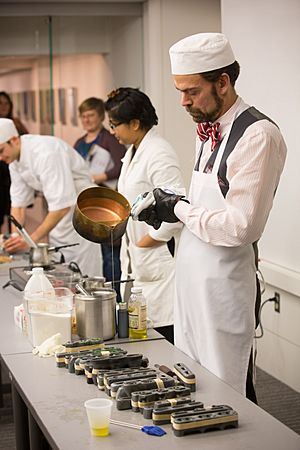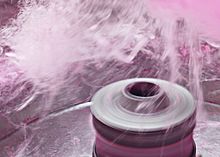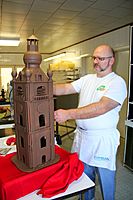Candy making facts for kids
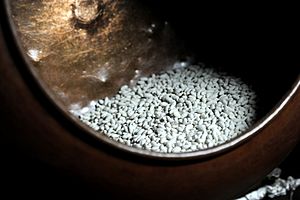
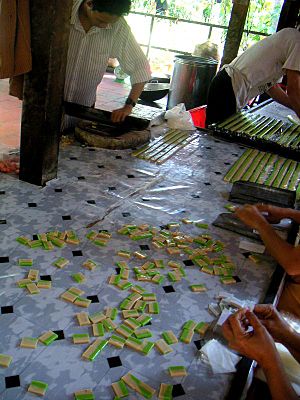
Candy making is all about preparing delicious sweets and treats! It involves making many different kinds of candies. Think about hard candies, jelly beans, gumdrops, taffy, liquorice, cotton candy, chocolates, fudge, caramel candy, and toffee.
Most candy is made by dissolving sugar in water or milk. This creates a syrup. This syrup is then boiled until it reaches a certain thickness or starts to turn brown, which is called caramelizing. The type of candy you get depends on the ingredients used and how long the mixture is boiled. Candies can be soft and chewy, or hard and crunchy! A chocolatier is a special person who makes treats from chocolate. This is different from a chocolate maker, who creates chocolate from cacao beans.
Contents
History of Candy Making
The way candy is made has changed a lot over time. It usually keeps up with new technologies. For example, when steam power became common in factories, candy factories started using it too.
Candy making and eating really grew during the Industrial Revolution in the 1800s. Before this time, candy was mostly made by hand. People either made it at home sometimes, or specialists made it in small local shops. But with new machines, candy became cheaper and much more was produced.
In the late 1800s and early 1900s, making candy in big factories was mostly a job for men. But making candy at home was often done by women. Candy was seen as sweet and delicate. So, making it at home, sharing it with friends, or selling small amounts fit with how women were expected to act back then. Most women who made and sold candy did it only for a season or to earn a little extra money. They rarely made enough to support themselves or their families. Even though many big candy brands were named after women, very few were actually owned or run by women.
The types of jobs in candy factories were also often separated by gender. Men and boys usually worked with cooking or operating machines. These jobs often had a higher risk of injury. Women were mostly hired for wrapping candies or putting them into packages. They also did hand-dipping candies in chocolate. The women who dipped chocolates were the best paid among female workers. However, their wages were almost always lower than even the lowest-paid male machine operators.
Hard Candy
Hard candy is also known as a boiled sweet. It is made from one or more syrups that are boiled to a very high temperature, around 160°C (320°F). After the syrup cools down, it becomes hard and brittle. That's why it's called hard candy! Recipes for hard candy often use syrups made from sucrose, glucose, or fructose. Sometimes, food coloring is added to make them colorful.
Sugar Stages
The final texture of candy depends on how much sugar is in it. As the syrup heats up, it boils and water evaporates. This makes the sugar concentration go up. A specific temperature means a certain sugar concentration. This is because adding sugar makes water boil at a higher temperature. Generally, higher temperatures and more sugar make hard, brittle candies. Lower temperatures make softer candies. Here are the different stages of sugar cooking:
| Stage | Temperature | Sugar concentration |
|---|---|---|
| thread (like syrup) | 110 to 112 °C (230 to 234 °F) | 80% |
| soft ball (like fudge) | 112 to 116 °C (234 to 241 °F) | 85% |
| firm ball (like soft caramel candy) | 118 to 120 °C (244 to 248 °F) | 87% |
| hard ball (like nougat) | 121 to 130 °C (250 to 266 °F) | 90% |
| soft crack (like salt water taffy) | 132 to 143 °C (270 to 289 °F) | 95% |
| hard crack (like toffee) | 146 to 154 °C (295 to 309 °F) | 99% |
| clear liquid | 160 °C (320 °F) | 100% |
| brown liquid (like liquid caramel) | 170 °C (338 °F) | 100% |
| burnt sugar | 177 °C (351 °F) | 100% |
These names came from how people used to test the syrup before thermometers were common. For the "thread" stage, you cool a little syrup and pull it between your fingers. If a thread forms, it's ready. This stage is used for making syrups. For other stages, a small spoonful of syrup is dropped into cold water. Then, people check how hard the lump is. A smooth lump means it's a "ball" stage. At the "soft crack" stage, the syrup forms threads that can bend a little. At the "hard crack" stage, the threads are brittle and break easily.
Some kitchens still use this method today. A candy thermometer is easier to use. However, the cold water test can adjust for things like altitude, which a thermometer doesn't do automatically.
Once the syrup reaches 171°C (340°F) or higher, the sugar molecules break down. This creates an amber-colored substance called caramel. This is not the same as caramel candy, but it gives caramel candy its main flavor.
Soft Candy
Cotton Candy
Cotton candy, also called candy floss, is a type of spun sugar. Machines used to make cotton candy have a spinning head. You pour granulated sugar into a small bowl inside this head. Sometimes, colored sugar or separate food coloring is used to add color. Heaters near the edge of the spinning head melt the sugar. The melted sugar is then pushed out through tiny holes by centrifugal force (the force that pushes things away from the center when spinning). The molten sugar hardens in the air. It is caught in a larger bowl that surrounds the spinning head. Once enough sugar builds up, a stick or cone is used to gather the sugar strands.
-
Cotton candy being prepared
Marshmallows

Marshmallows are made by whipping air into gelatin, corn syrup, and sugar. Marshmallows have been around for a long time! In ancient Egypt, people made a sweet treat using an extract from the root of the marshmallow plant (Althaea officinalis). They mixed it with nuts and honey. Another old recipe used the soft inner part of the marshmallow plant. Today, marshmallows are often made in factories using a process called extrusion. This pushes the mixture through a shaped opening.
Chocolatiering
Chocolatiering is the art of making treats from chocolate. It involves special techniques like tempering, molding, and sculpting. Tempering is a heat treatment for chocolate. It involves heating and cooling the chocolate carefully. This makes the chocolate shiny and gives it a nice 'snap' when it breaks. Molding is a way to make chocolate pieces into specific shapes. You pour liquid chocolate into a mold and let it harden. Sculpting is like making three-dimensional art with chocolate. It can involve using molds and different chocolate pieces. You can also decorate the chocolate with designs.
-
A chocolatier making chocolate eggs
Safety in Candy Making
Making candy can be risky because it uses very hot sugar and melted chocolate. Boiling sugar often gets hotter than 150°C (300°F). It tends to stick to skin, causing painful burns and blisters. Safety programs in factories focus on keeping workers away from hot food and equipment. They also try to prevent splashes, as even small drops can cause burns.
Some ingredients, especially in powder form, can irritate eyes and lungs if breathed in. So, protecting workers means reducing their exposure to these ingredients. Measures to control dust can help prevent health problems for workers.
Controlling dust is also important to prevent dangerous dust explosions. Sugar dust and other ingredient dust can explode. These explosions have destroyed factories and harmed candy makers.
Tools and Machines
Many different tools and machines are used to make candy. These range from simple kitchen tools like bowls and spoons to complex factory machinery.
Because getting the exact temperature is super important for some candies, a common tool is the candy thermometer. Inexpensive candy thermometers can measure food temperatures up to about 160°C (320°F). Those used in big candy factories can measure even higher temperatures.
A starch mogul is a machine used in candy factories. It helps shape soft candies or candy centers from syrups or gels. These centers might then go through a chocolate enrober. This machine coats them in chocolate.
Pay for Candy Makers
Even though candy makers are often very skilled, they don't usually get paid a lot. For example, a chocolatier in the US typically earns about $21,000 per year.


